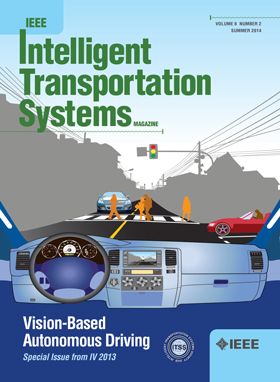Driving Behavior Model for Multi-Vehicle Interaction at Uncontrolled Intersections Based on Risk Field Considering Drivers’ Visual Field Characteristics
IF 7.9
1区 工程技术
Q1 ENGINEERING, CIVIL
IEEE Transactions on Intelligent Transportation Systems
Pub Date : 2024-10-03
DOI:10.1109/TITS.2024.3465442
引用次数: 0
Abstract
In most studies on modeling driving behavior at uncontrolled intersections, multi-vehicle interaction scenarios are usually categorized and modeled separately as moving-across behavior and merging behavior. However, it is inappropriate to use a single-behavior model to accurately represent general driving behavior in uncontrolled intersections. In this case, we constructed a general driving behavior model for multi-vehicle interaction at uncontrolled intersections. Initially, the IMM model is employed to anticipate the movement of the vehicle within the driver’s visual field. The risk field theory is applied to assess potential hazards that the vehicle might confront, drawing from the risk homeostasis theory and preview-follower theory, which aids in determining a trajectory that aligns with the drivers’ real-life actions while also meeting the risk constraints. Drivers’ heterogeneity is reflected by risk threshold. This model can simulate driver behavior in traffic congestion at uncontrolled intersections by adjusting risk thresholds when the vehicles are caught in a deadlock situation. Results show that our model can accurately reproduce the priority and trajectory of vehicles crossing the intersection and resolve multi-vehicle conflicts within a reasonable time. This model can be used for traffic simulation at uncontrolled intersections and to provide test validation for automated driving systems.基于风险场并考虑驾驶员视野特征的多车交叉口驾驶行为模型
在大多数关于非受控交叉口驾驶行为建模的研究中,多车交互场景通常被分为移动交叉行为和并线行为,并分别进行建模。然而,使用单一行为模型来准确表示不受控制交叉路口的一般驾驶行为是不合适的。在这种情况下,我们构建了在不受控制的交叉路口多车交互的一般驾驶行为模型。最初,我们采用 IMM 模型来预测驾驶员视野内车辆的移动。借鉴风险平衡理论和预览-跟随者理论,运用风险场理论评估车辆可能面临的潜在危险,从而帮助确定与驾驶员实际行动相一致的轨迹,同时满足风险约束条件。驾驶员的异质性通过风险阈值反映出来。当车辆陷入僵局时,该模型可以通过调整风险阈值来模拟驾驶员在不受控制的交叉路口交通拥堵中的行为。结果表明,我们的模型可以准确再现车辆通过交叉口时的优先级和轨迹,并在合理的时间内解决多车冲突。该模型可用于非受控交叉口的交通模拟,并为自动驾驶系统提供测试验证。
本文章由计算机程序翻译,如有差异,请以英文原文为准。
求助全文
约1分钟内获得全文
求助全文
来源期刊

IEEE Transactions on Intelligent Transportation Systems
工程技术-工程:电子与电气
CiteScore
14.80
自引率
12.90%
发文量
1872
审稿时长
7.5 months
期刊介绍:
The theoretical, experimental and operational aspects of electrical and electronics engineering and information technologies as applied to Intelligent Transportation Systems (ITS). Intelligent Transportation Systems are defined as those systems utilizing synergistic technologies and systems engineering concepts to develop and improve transportation systems of all kinds. The scope of this interdisciplinary activity includes the promotion, consolidation and coordination of ITS technical activities among IEEE entities, and providing a focus for cooperative activities, both internally and externally.
 求助内容:
求助内容: 应助结果提醒方式:
应助结果提醒方式:


